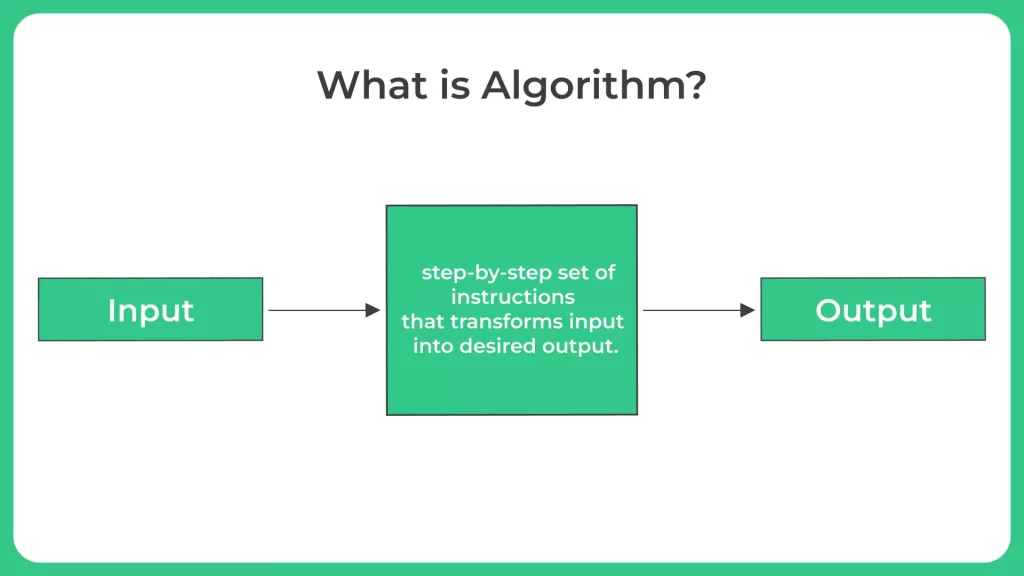Analysis of Algorithm in Python

Introduction to Analysis of Algorithm
An Analysis of algorithm is a step by step procedure designed to solve a specific problem or accomplish a particular task. It acts as a blueprint that guides computers in performing tasks efficiently and accurately.
From simple calculations to sophisticated data processing, algorithms power a wide range of operations.
Introduction to Analysis of Algorithm
An Analysis of algorithm is a step by step procedure designed to solve a specific problem or accomplish a particular task. It acts as a blueprint that guides computers in performing tasks efficiently and accurately.
From simple calculations to sophisticated data processing, algorithms power a wide range of operations.
What is Algorithm Analysis?
Algorithm analysis is the process of evaluating the efficiency of an algorithm in terms of time and space it consumes. It helps us understand how well an algorithm performs, especially as the size of the input grows.
This is crucial for choosing the best algorithm for a problem, especially when working with large data sets or limited resources.
- Algorithm analysis helps measure time and space complexity to predict performance.
- It ensures optimal algorithm selection based on input size and system constraints.


Types of analysis of algorithm
What are Asymptotic Notations ?
- Asymptotic notations are mathematical tools used in computer science and mathematics to describe the behavior of functions as their input values approach infinity.
- They help us analyze the efficiency and performance of algorithms by providing a concise way to express how the algorithm’s time or space requirements grow relative to the input size.
There are three main types of asymptotic notations:
- Big O Notation (O)
- Omega Notation (Ω)
- Theta Notation (θ)
Algorithm Behavior Cases
Example for Best Case Analysis:
An example of best-case analysis for a simple algorithm: finding the minimum element in an array.
Algorithm: Finding the Minimum Element in an Array
def find_minimum(arr):
min_val = arr[0] # Assume the first element is the minimum
for num in arr:
if num < min_val:
min_val = num
return min_val
Let’s analyze the algorithm’s behavior in the best-case scenario:
- The first element is the minimum, so only one comparison is made (num < min_val), which is true for the first element itself.
- As a result, the loop iterates through the array only once (n-1 iterations are avoided).
- The algorithm then returns the minimum element (which is the first element) in constant time.
Example for Worst Case Analysis:
An example of worst-case analysis for the linear search algorithm. Linear search is used to find the position of a target value within an array.
Algorithm: Linear Search
def linear_search(arr, target):
for i, num in enumerate(arr):
if num == target:
return i # Found the target at index i
return -1 # Target not found in the array
Let’s analyze the algorithm’s behavior in the worst-case scenario:
- The target value is not found until the last element of the array.
- For each element, a comparison is made (num == target).
- The loop iterates through the entire array of size ‘n’.
- The algorithm then returns -1 to indicate that the target is not found.
Example for Average Case Analysis:
An example of average-case analysis for the binary search algorithm. Binary search is a search algorithm used to find the position of a target value within a sorted array.
Algorithm: Binary Search
def binary_search(arr, target):
left, right = 0, len(arr) - 1
while left <= right:
mid = (left + right) // 2
if arr[mid] == target:
return mid # Found the target at index mid
elif arr[mid] < target:
left = mid + 1 # Target is in the right half
else:
right = mid - 1 # Target is in the left half
return -1 # Target not found in the array
Average-Case Analysis: For the average-case analysis, we consider a scenario where the target value is randomly distributed within the array. This scenario represents the average behavior of the algorithm.
- In binary search, at each step, we halve the search interval. In each iteration, we eliminate roughly half of the remaining elements. If we denote the size of the remaining interval as ‘n’, after each step, the size reduces to approximately ‘n/2’.
- The number of steps required to reduce the interval to a single element is roughly log₂(n), where ‘n’ is the size of the array.
- Hence, on average, the algorithm requires log₂(n) iterations to find the target, which results in a time complexity of O(log n).


Prime Course Trailer
Related Banners
Get PrepInsta Prime & get Access to all 200+ courses offered by PrepInsta in One Subscription
What is the Need for Analysis of the Algorithm ?
Efficiency Evaluation: Algorithms can solve the same problem in various ways, but their efficiency can differ significantly. By analyzing algorithms, we can determine how well they perform in terms of time and space usage. This information helps us choose the most suitable algorithm for a particular problem, ensuring optimal resource utilization.
Resource Management: Efficient algorithms are essential for conserving valuable resources like time and memory. In applications where speed or memory usage is critical, selecting the right algorithm can make a substantial difference in overall performance.
What is Recursive Complexity?
Recursive complexity refers to the analysis of the time and space complexity of algorithms that employ recursion as a fundamental component of their design. Recursive algorithms are algorithms that solve a problem by solving smaller instances of the same problem.
Analyzing the complexity of recursive algorithms involves understanding how the algorithm breaks down the problem into smaller subproblems and how it combines the solutions of these subproblems to solve the original problem.
Recursive algorithms typically involve two main components:
- the base case
- the recursive case
Base Case: This is the simplest scenario where the problem can be solved directly without further recursion. It serves as the stopping condition for the recursion.
Recursive Case: In this step, the problem is divided into smaller subproblems that are of the same nature as the original problem. The algorithm applies the same logic to solve these subproblems recursively until they are reduced to the base case.
Steps to determine the recursive complexities of algorithms:
Code complexity
Code complexity, also known as program complexity, refers to the measure of how intricate or convoluted a computer program is. It encompasses various aspects of code design, structure, and readability that impact the maintainability, reliability, and understandability of the software. Code complexity is an important concept in software engineering as it directly influences the quality and longevity of software systems.
Several factors contribute to code complexity:
Let’s consider examples of how if-else operations and nested loops can contribute to code complexity.
Example 1: If-Else Operations
def calculate_grade(score):
if score >= 90:
grade = 'A'
elif score >= 80:
grade = 'B'
elif score >= 70:
grade = 'C'
elif score >= 60:
grade = 'D'
else:
grade = 'F'
return grade
In this example, we have an if-else chain to determine the grade based on a given score. While this code is not excessively complex, it could become more intricate as additional conditions and grades are added.
- As the number of conditions grows, the code’s readability might decrease, especially if the conditions involve complex comparisons.
- This can make it harder for programmers to understand and maintain the code, increasing its cognitive complexity.
Example 2: Nested Loops
def print_multiplication_table(n):
for i in range(1, n+1):
for j in range(1, n+1):
product = i * j
print(f"{i} * {j} = {product}")
In this example, we have nested loops to print a multiplication table up to a specified value n. The nested loops lead to an O(n^2) time complexity, which means the number of iterations grows quadratically with the input n.
While this code is relatively straightforward, nested loops can become very complex, especially if each loop contains intricate logic. This complexity can make it difficult to reason about the behavior of the code and to predict its performance with larger input values.
To manage code complexity involving if-else operations and nested loops:
If-Else Operations:
- Keep conditions simple and clear.
- Use meaningful variable and condition names to enhance readability.
- Consider using lookup tables or dictionaries for mapping values to outcomes if the number of conditions becomes extensive.
Nested Loops:
- Limit the depth of nesting to maintain readability.
- Extract complex logic into separate functions to reduce nesting depth.
- Comment and document nested loops to explain their purpose and functionality.
- Consider whether alternative approaches, such as using matrix operations, can achieve the same goal with lower complexity.
Conclusion
In a digital landscape driven by speed and efficiency, algorithm analysis emerges as a crucial discipline. By evaluating time and space complexity, utilizing mathematical notations like Big O, and applying empirical and theoretical analysis, developers can optimize algorithms for various applications. This optimization, in turn, paves the way for enhanced user experiences, technological innovation, and problem-solving.
FAQs
Analysis of Algorithm helps measure efficiency in time and space, ensuring faster and more resource friendly programs. Proper Analysis of Algorithm is key to building optimized software.
Time complexity is vital in the Analysis of Algorithm as it shows how running time grows with input size. Understanding it helps improve algorithm performance.
Asymptotic notations like Big O are tools in the Analysis of Algorithm to describe how algorithms scale with input size. They simplify comparing efficiency between algorithms.
Recursive complexity analyzes how recursive algorithms perform in terms of time and space. It’s an important part of the Analysis of Algorithm for recursive functions.
Get over 200+ course One Subscription
Courses like AI/ML, Cloud Computing, Ethical Hacking, C, C++, Java, Python, DSA (All Languages), Competitive Coding (All Languages), TCS, Infosys, Wipro, Amazon, DBMS, SQL and others






Login/Signup to comment